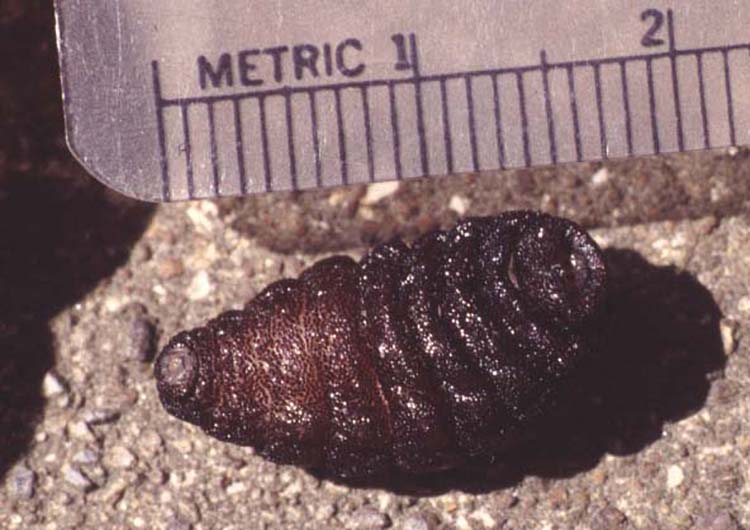Bot flies comprise the family Cuterebridae, and are parasites that attack mammals. Their larvae live inside living mammals. We have three species of them in New Hampshire. Our most common bot fly is Cuterebra fontinella, reported to occur in most of the continental US (except Alaska), plus southern Canada and Northeastern Mexico.
Adults of C. fontinella are large, robust flies, with large eyes, and bodies 15 to 17mm long (roughly 5/8 inch). They are black with pale yellow markings and smoky wings. In the Durham area, most of the adults are found from June through September. 63% of the southeastern NH specimens in the UNH insect collection were found during August, as was the adult in my photograph.
White-footed mouse is the most common host for C. fontinella. It has also been reared from house mouse, Norway rat and roof rat. Other reports (species not determined) are from voles and chipmunks. Larvae (probably this species) have been found parasitizing dogs and humans in New Hampshire. The female flies lay eggs singly on vegetation or substrate that is frequented by small mammals (especially rodent runs and near nests). Odor may be a cue to help the female flies locate such spots. About one week after laying, the eggs are ready to hatch, but they must wait for a sudden increase in temperature to trigger that hatching. A warm body coming in contact with the egg triggers the egg to hatch within a few seconds. Then the tiny larva climbs aboard the animal and crawls through the fur, looking for a body opening to enter.
The just-hatched larva of C. fontinella enters white-footed mouse through mucous-lined openings like mouth, eye, nose or anus. It migrates through the body for about five days, ending up in tissues just below the skin, in the rear ventral region. It cuts a breathing opening through the skin and develops at that site for about 21 days. The rear end of the larva and its spiracles (openings to its breathing system) project from the opening. In the photo of the mouse, the larva is the dark brown spiny protrusion, and the spiracles are brown dots inside a lighter circular tan area. As the larva grows, a boil-like swelling (called a warble) develops in the host. Once the larva has completed its growth, it exits the host to pupate, and the wound heals over. In humans and dogs the wound is large, sore and inflamed.
Fully grown larvae are 16-20mm (almost 1 inch) long, dark brown and covered with short, stiff cone-shaped bristles. The head end is narrow, while the rear end is broad and blunt. In late August, I have found white footed mice with live larvae, and a colleague gave me a photo of a Peromyscus sp. (white-footed or deer mouse) caught by his cat that had 16 bot fly larvae!
Compared to native host species (like white-footed mouse), non-native hosts (Norway rat, black rat, house mouse, etc.) suffer more serious consequences from bot fly parasitization, and can die.
The two other species of bot flies in New Hampshire are both uncommon. Cuterebra emasculator attacks eastern chipmunk and gray squirrel. Cuterebra ruficrus is in southern NH, and attacks rabbits and hares.
The first week of September is the time when infestation of dogs (sometimes other pets) are often discovered. In humans, the most common New Hampshire cases involve sunbathers in late August or early September. You can significantly reduce the chances of being attacked, by sunbathing on a blanket, rather than directly on the grass. This is because being parasitized requires that your warm skin come in direct contact with an egg that is ready to hatch. If you or your pet is attacked by a bot fly larva, your physician or veterinarian can remove it, and treat the wound.

References: Biology and range are reported in: Sabrosky, C.W. 1986. North American Species of Cuterebra, the rabbit and rodent bot flies (Diptera: Cuterebridae). Entomol Soc. America Thomas Say Foundation Monograph, College Park, MD.
Two more accessible references are:
Medical & Veterinary Entomology by Gary Mullen and Lance Durden, Academic Press, Boston, MA. 2002. (pgs 335-6) ISBN 0-12-510451-0
Richard Gingrich. 1981. Journal of Parasitology, volume 67, pgs 398- 402. Migratory Kinetics of Cuterebra fontinella (Diptera:Cuterebridae) in the White-Footed Mouse, Peromyscus leucopus.
July 2017
Extension Services & Tools That Help NH Farmers Grow
Newsletters: Choose from our many newsletters for production agriculture
Receive Pest Text Alerts - Text UNHIPM to (866) 645-7010


